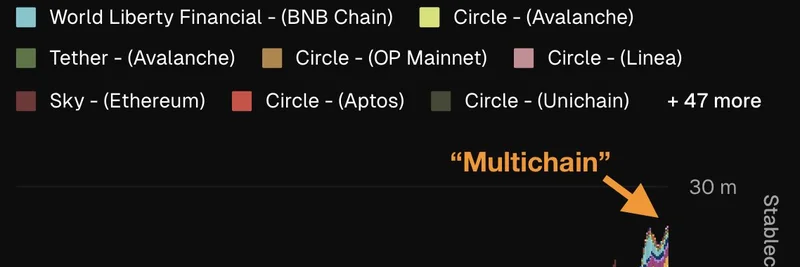In the ever-evolving world of cryptocurrencies, stablecoins have become the backbone for trading, payments, and even meme token ecosystems. A recent post from Token Terminal highlights a fascinating trend: stablecoin usage is moving from a "dualchain" era to a truly "multichain" one. Let's break this down and see what it means for the broader blockchain space, including how it impacts meme tokens.
チャートの読み方:DualからMultiへ
The chart shared in the original tweet tracks monthly stablecoin senders broken down by issuer (like Tether or Circle) and the blockchain they're using (such as Tron, Ethereum, Solana, and more). Stablecoins are cryptocurrencies pegged to stable assets like the US dollar, making them less volatile and ideal for everyday transactions in crypto.
Early on, from around 2018 to 2022, the data shows a "dualchain" dominance. That's mostly blue and a bit of pink—Tether on Tron (the dark blue bar) and Tether on Ethereum (lighter pink). These two setups handled the bulk of activity because Tron offers super low fees and fast transactions, while Ethereum is the go-to for DeFi (decentralized finance) integrations.
But look at the right side of the chart: it's a rainbow explosion! By 2024 and into 2025, we're seeing contributions from Circle on Solana (yellow), Base (white), Polygon (green), and a bunch of others like Arbitrum, Avalanche, and even newer chains like Unichain. The arrow points to "Multichain" with over 30 million monthly senders, a huge jump from the earlier days.
This shift means users aren't stuck on one or two chains anymore. They're spreading out to wherever fees are low, speeds are high, and integrations are seamless. For meme token enthusiasts, this is big news—meme coins often thrive on hype and quick trades, and multichain stablecoins make it easier to jump between ecosystems without high bridging costs.
マルチチェーン急増の理由
Several factors are driving this trend:
Layer 2 Solutions and New Chains: Blockchains like Base (built on Ethereum) and Solana have exploded in popularity due to their scalability. Circle's USDC, for example, is now native on these, reducing reliance on Ethereum's sometimes pricey gas fees.
Issuer Expansion: Tether (USDT) and Circle (USDC) are aggressively deploying on more chains. Tether's on everything from Celo to TON, while Circle hits OP Mainnet and Linea. This "multichain" strategy makes stablecoins more accessible, boosting adoption.
User Demand for Efficiency: In a world where meme tokens can pump on Solana one day and Ethereum the next, traders need stablecoins everywhere. No one wants to pay extra to bridge funds across chains.
Even the replies to the tweet echo this excitement. One user mentions Polkadot's potential to join the fray, thanks to its low costs. Another points out missing deployments like on Plasma or HyperEVM, hinting at even more growth ahead.
ミームトークンとブロックチェーン実務者への影響
At Meme Insider, we focus on how these trends affect meme tokens. Multichain stablecoins lower barriers for retail users to enter meme coin markets on various chains. Imagine swapping USDT on Tron for a hot Solana meme without friction—that's the future we're heading toward.
For developers and traders, this data from Token Terminal is a goldmine. It shows where liquidity is flowing, helping you decide which chains to build or trade on. If you're into DeFi, keep an eye on chains like Avalanche or Polygon, where Circle's presence is growing.
Stablecoins aren't just boring dollar pegs; they're the fuel for the crypto economy. As they go multichain, expect meme token volumes to follow suit, creating more opportunities for gains (and yes, some losses—always DYOR!).
If you're tracking similar trends, check out Token Terminal's dashboard for more in-depth analytics. What's your take on this shift? Drop a comment below!



